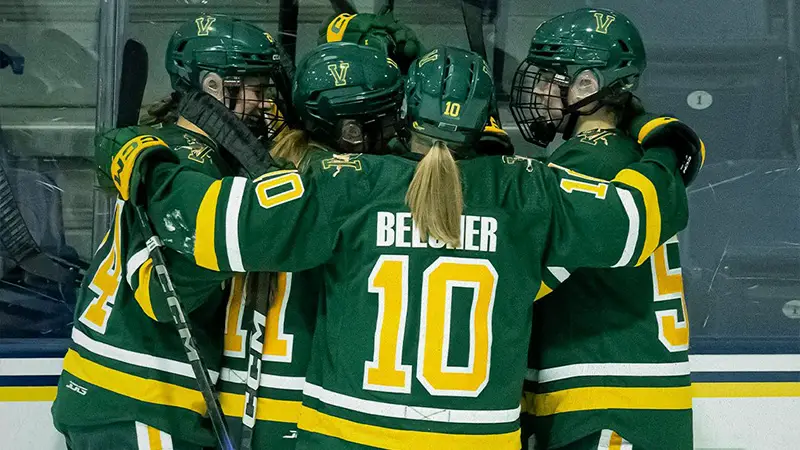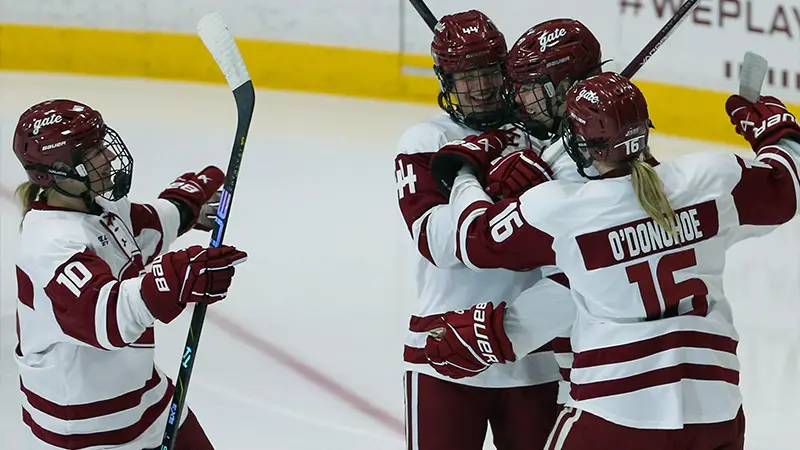Women’s hockey has gained significant recognition and a strong following worldwide. While it shares many similarities with the men’s game, one noticeable difference is the limited presence of hitting, or body checking.
In this blog post, we delve into the reasons behind why hitting is restricted in women’s hockey.
The decision to limit hitting in women’s hockey is not arbitrary; it reflects a careful consideration of factors such as player safety, physiological differences, and the overarching goal of promoting skill development and inclusivity.
Understanding these reasons is essential to appreciate the unique qualities and appeal of women’s hockey.
We’ll explore how these restrictions affect the sport’s competitiveness, how international rules influence the game, and whether there are exceptions to the hitting rules.
By the end of this post, you’ll have a comprehensive understanding of why women’s hockey embraces a different approach to physicality compared to its male counterpart.

What Is Hitting in Women’s Hockey?
In women’s hockey, “hitting” refers to the physical contact or body checks that players use to gain possession of the puck or disrupt their opponents.
However, it’s important to note that the rules regarding hitting in women’s hockey can vary depending on the level of play and the specific league or organization.
In general, women’s hockey has traditionally been known for having less physical contact compared to men’s hockey. Body checking, which involves using your body to knock an opponent off the puck, is more limited in women’s hockey.
Rules and regulations governing body checking in women’s hockey often focus on safety and protecting players from dangerous collisions.
At the professional and international levels, there may be stricter rules regarding body checking, with an emphasis on maintaining the safety of the players. In contrast, at the youth and amateur levels, body checking may be less common or restricted to certain age groups.
To get the most accurate and up-to-date information on the rules regarding hitting in women’s hockey, it’s essential to consult the rulebook of the specific league or organization in question, as rules can evolve over time.
Why Is There No Hitting In Women’s Hockey?
The absence or limited use of body checking (hitting) in women’s hockey is a result of several factors and considerations, which are aimed at maintaining the safety of players and promoting the growth of the sport.
Here are some key reasons for the lack of hitting in women’s hockey:
Safety Concerns
The most prominent reason for restricting body checking in women’s hockey is the emphasis on player safety.
Body checking can lead to significant physical contact and collisions, which can result in injuries, including concussions and musculoskeletal injuries.
Given that safety is a top priority, especially at the youth and amateur levels, governing bodies have opted for rules that reduce the risk of harm.
Different Physiological Considerations
On average, men tend to have larger body sizes, greater muscle mass, and different physical characteristics compared to women. These differences can affect how body checking is executed and received.
Women’s hockey recognizes these disparities and has adapted the rules accordingly to ensure that the sport remains competitive while minimizing the potential for harm.
Promoting Skill Development
Women’s hockey places a strong emphasis on skill development, teamwork, and strategic play. By limiting body checking, the focus shifts toward honing skating, passing, shooting, and defensive techniques.
This approach encourages players to develop their skills and promotes a more fluid, finesse-oriented style of play.
Attracting and Retaining Participants
By reducing the physicality of the sport, women’s hockey aims to create a welcoming environment that encourages participation from players of all ages and skill levels.
This inclusivity helps grow the sport and ensures that players can enjoy the game without feeling intimidated by the prospect of heavy body checking.
Aligning with International Standards
To maintain consistency with international standards and foster the growth of women’s hockey on a global scale, many organizations adopt rules that limit body checking.
This standardization helps ensure a level playing field for teams from different countries and regions.
Evolving the Game
Hockey, like any sport, evolves over time. Rules and regulations adapt to changing circumstances and priorities. The decision to limit body checking in women’s hockey reflects a broader shift in the sport toward prioritizing skill and safety.
It’s important to note that while body checking is less common in women’s hockey, it is not entirely absent. Depending on the level of play, rules may vary, and body checking may be allowed to varying degrees.
Nonetheless, the primary aim remains to protect players, promote skill development, and make the sport accessible and enjoyable for all participants.
Hitting Rules in Women’s Hockey

The rules regarding hitting (body checking) in women’s hockey can vary depending on the specific league, level of play, and governing organization.
While women’s hockey generally emphasizes player safety and skill development, there are still some guidelines and rules that dictate when and how hitting can occur.
Here are some general principles:
Age and Skill Level
Hitting rules often depend on the age group and skill level of the players. In youth and amateur leagues, body checking is typically less common or may be limited to certain age divisions.
In higher-level and professional women’s hockey, body checking may be allowed but with stricter enforcement of safety rules.
Penalties
Illegally hitting an opponent can result in penalties, such as a minor penalty, a major penalty, or even a game misconduct, depending on the severity of the infraction.
These penalties can result in the offending player serving time in the penalty box, and her team playing shorthanded.
Legal Body Checking Zones
Some leagues or organizations may designate specific zones on the ice where body checking is allowed, such as along the boards in the defensive zone. Players may be allowed to use body checks in these areas but not in open ice.
Checking from Behind
Checking an opponent from behind is typically considered dangerous and is often penalized severely, as it can lead to serious injuries. Most women’s hockey organizations strongly discourage checking from behind.
Size and Strength
Rules may take into account the size and strength disparities between players. Overly aggressive or mismatched body checking can result in penalties, even if the check is legal.
Intent and Fair Play
Referees often consider the intent of a body check. A check that is excessively aggressive or appears to be intended to injure the opponent can result in penalties or ejections. Fair play and respect for opponents are emphasized.
International Rules
At the international level, such as in IIHF (International Ice Hockey Federation) competitions, body-checking rules may be standardized and closely aligned with safety regulations. These rules are designed to ensure consistency in play across different countries.
Continual Rule Updates
Hockey organizations continually update rules to enhance player safety and adapt to the evolving nature of the game. It’s essential for players, coaches, and officials to stay informed about the latest rule changes in women’s hockey.
It’s important to note that while there are rules and guidelines governing body checking in women’s hockey, the specific rules can vary from one league to another.
Players and coaches should familiarize themselves with the rules of the particular organization under which they are playing to ensure they comply with the regulations and prioritize safety on the ice.
Penalties for Illegal Hitting in Women’s Hockey

Penalties for illegal hitting (body checking) in women’s hockey can vary depending on the specific league, level of play, and governing organization.
However, there are common penalties that are typically applied when a player engages in illegal hitting. These penalties are designed to discourage dangerous play and maintain player safety.
Here are some of the common penalties for illegal hitting in women’s hockey:
Minor Penalty
In many cases, minor penalties are assessed for illegal hits that are not overly aggressive but still violate the rules. A minor penalty typically results in the offending player serving two minutes in the penalty box, and her team plays shorthanded for that duration.
Major Penalty
More severe illegal hits, especially those that result in injury to the opponent, can lead to a major penalty. A major penalty usually results in the player serving five minutes in the penalty box.
The opposing team often gets a power play for the full duration of the penalty.
Game Misconduct
In cases of exceptionally dangerous or reckless hits, or if a player accumulates multiple penalties, a game misconduct penalty may be assessed.
A player receiving a game misconduct penalty is ejected from the game, and her team is shorthanded for a specified duration.
Match Penalty
The most severe penalty in hockey is a match penalty. It is reserved for extremely dangerous plays, such as deliberate attempts to injure an opponent.
A player receiving a match penalty is ejected from the game and often faces additional disciplinary action, including potential suspensions.
Suspensions
Depending on the severity of the illegal hit and the league’s rules, a player may be subject to additional disciplinary action, including suspensions for a specified number of games.
Suspensions are typically determined by the league’s disciplinary committee.
Fines
Some leagues or organizations may impose fines on players who engage in illegal or dangerous hits as an additional deterrent.
Ejection from the Game
In less severe cases, a player may be ejected from the game without receiving a specific penalty. The player is not allowed to return to the game after being ejected.
Game Misconduct and Match Penalties for Checking from Behind
Checking from behind, which is considered especially dangerous, often results in game misconduct or match penalties, even if no injury occurs.
It’s important to note that the specific penalties and their severity can vary depending on the league, level of play, and the judgment of the officials on the ice.
The main goal of these penalties is to promote fair play, protect player safety, and maintain the integrity of the game. Players, coaches, and officials should be familiar with the rules and penalties specific to their league or organization to ensure safe and fair competition.
FAQs
Why is hitting limited in women’s hockey?
Hitting is restricted in women’s hockey to prioritize player safety. The physical differences between male and female players, along with the sport’s aim to foster skill development, led to rules that minimize the risk of injuries associated with aggressive body checking.
Is there any hitting at all in women’s hockey?
Yes, some hitting is allowed in women’s hockey, but it is typically less frequent and regulated compared to men’s hockey.
Rules vary by league and skill level, with an emphasis on safe and controlled body checks in designated areas of the ice.
Does limiting hitting affect the competitiveness of women’s hockey?
Limiting hitting doesn’t diminish competitiveness. Women’s hockey focuses on skill, teamwork, and strategy, creating an exciting and competitive game.
Skillful play, rather than physicality, defines the sport, making it appealing to both players and fans.
How do international rules influence hitting in women’s hockey?
International hockey organizations, like the IIHF, often set guidelines that prioritize player safety.
These rules help maintain consistency in women’s hockey worldwide, emphasizing fair play and safe competition across different countries and regions.
Are there any exceptions to the hitting rules in women’s hockey?
Hitting rules can vary by age group and level of play. In some cases, more physical contact might be allowed in older age divisions.
However, safety remains a paramount concern, and rules aim to strike a balance between competitiveness and player well-being.
Wrapping Up
The absence of hitting in women’s hockey is not a sign of weakness or a lack of competitiveness; it’s a deliberate choice made to prioritize safety, skill development, and inclusivity.
By focusing on these core principles, women’s hockey has carved out its own distinct identity, captivating audiences with skillful play and teamwork.
International rules help maintain consistency and fairness across borders while varying regulations by age and skill level ensure a balance between competitiveness and player well-being.
Women’s hockey continues to thrive and evolve, attracting players of all backgrounds and inspiring a new generation of athletes.
As we celebrate the achievements of women in sports, it’s crucial to recognize that the absence of hitting in women’s hockey is not a limitation but a reflection of a sport that values athleticism, skill, and the safety and well-being of its participants above all else.




Benjamin Kenyon